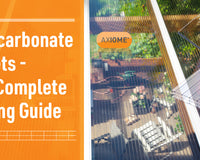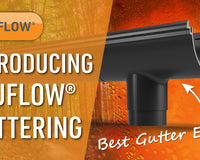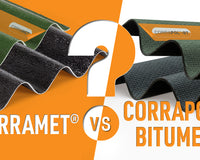Everyone knows - replacing the sheeting on a polytunnel after high winds, snow or just general winter weather can be a nightmare. Polythene sheeting has a very limited lifespan and is susceptible to tears and rips the older it gets. For this reason, many people are now rebuilding or building their polytunnels using polycarbonate sheets to create a heavy duty polytunnel.
Unsurprisingly, with the increasing popularity installation methods for polycarbonate polytunnels have become much easier. This is great news for DIYers who, with a little DIY experience, can complete their poly tunnel rebuild without the expensive costs of paying a company to do so.
A polytunnel greenhouse is one of the best growing environments for homeowners to level up their gardening and growing opportunities. They offer unrivalled protection from the elements and an excellent warm climate.
The main benefit of installing a polycarbonate polytunnel is it extends your growing season by several months, What’s more, when upgraded with polycarbonate a grow tunnel can last many years with minimal maintenance.
Why Build Your Polycarbonate Polytunnel Yourself?
Building your poly tunnel cover yourself has three benefits:
- It can save you significant money
- You can build to suit your exact garden space measurements
- It’s a great way to learn a new DIY skill for future roofing projects
What’s more, it’s another project where you can enjoy working outdoors, get some good exercise and have a huge sense of achievement once finished – after all, that’s what DIY is all about.
What are the Main Parts Required to Roof a Polytunnel?
To successfully install your poly tunnel cover you will want to purchase four main components:
- Axiome 10mm Polycarbonate Sheets
- Snapa Clear H Sections
- Alukap Fixing Buttons – White
- Snapa Clear C Sections
It’s quite simple. The 10mm twinwall polycarbonate sheets form the main cover and are joined together by the Clear H sections. Then the fixing buttons are used to secure the sheets down to your frame, along the timber battens. Finally, the Clear C Sections are used to seal along the bottom open edge of the sheets.

Everything you need for your polytunnel cover can be bought right here from Clear Amber Shop. Polycarbonate tunnels have various trade names including polycrub, poly pod and grokurv but essentially all of them follow a similar format.
Why are Polycarbonate Sheets Used for Building Polytunnels?
Polycarbonate sheets are used to build polytunnels primarily because of their unrivalled strength which makes them suitable for cold bending over the tunnel radius. Axiome 10mm Sheets tend to be the most popular thickness of polytunnel plastic as they offer the right mix of flexibility and strength. Thinner thicknesses can be too flexible and not wind-resistant enough.
Ensure you buy a reputable brand, like Axiome® polycarbonate, that has been used for polytunnels for many years, as not all 10mm twinwall polycarbonate is of equal quality. Many twinwall polycarbonate sheets aren’t fully UV protected. Does this matter? Absolutely, UV protection prevents polycarbonate sheets from going yellow, cloudy and brittle over time, due to the sunlight.
UV protection is particularly important for sheets on poly tunnels as they are installed cold bent so are stressed, meaning any brittleness will exacerbate the risk of cracks or splits. To be clear, Polycarbonate sheets which are ‘UV resistant’ are not UV protected. They have very little protection from brittleness so will tend to have a very short lifespan and minimal warranty.
The other point to be aware of is that not all polycarbonate sheets are the same weight and quality. A lot of greenhouse polycarbonate sheets are lighter and low-quality meaning that they will not bend properly and can warp during installation.
You must ensure you purchase the right polytunnel plastic sheets as they are critical to the strength of the polytunnel. Particularly as they are installed curved over, or cold bent. If you have any doubts or questions, please reach out to our team for further assistance.
Buying the Right Polycarbonate Sheets for a Polytunnel
It is important to purchase the right size polytunnel plastic for your grow tunnel. The length of the sheets determines the width of your tunnel and the width affects installation.
As an approximate guide here are the length of sheets required to build different width Polytunnels. Remember, it depends on the radius of your curve as with the longer sheets there can be a bit of flexibility in the width of your tunnel.
| Width of Polytunnel | Length of Sheets Required |
| 2.5 metres | 5.5 metres |
| 3 metres | 6 metres |
| 4 metres | 7 metres |
The most common polycarbonate width for polytunnels is 1 metre wide (or 1050mm) however for an easier installation you can use narrower sheets. Don’t be tempted to use wider sheets as beyond 1 metre wide they are very hard to install, because they get too wide to reach over and fix down.
What Tint of Polycarbonate Sheets are Best for a Polytunnel?
Clear polycarbonate sheets are by far the most popular tint option for Polytunnels. They provide the most natural light and create excellent growing conditions. The majority of installers use clear polycarbonate sheets on polycarbonate for this reason.
There are also opal and bronze polycarbonate options if you want a different style. Opal polycarbonate sheets will tend to create a bright interior and reduce heat absorption very slightly. They are primarily used on polytunnels that are being used for multi proposes, for example, an outdoor living area at one end.
Bronze Polycarbonate sheets reduce sun glare but also reduce the sunlight so are used for non-growing projects. Both Opal and Bronze can be used with clear to create a mixed polytunnel to suit multi-function tunnels.

How Many Sheets Are Needed To Build A Polytunnel?
It depends on the overall length of the Polytunnel you are building but keeping the sheet widths at 1 metre wide simply divide your total length by 1 metre. Then add two sheets for the ends of the polycarbonate tunnels.
(Total length/Sheet Width) + 2 = Sheets Quantity (round up to whole sheets)
For example, for a 6200mm length you would calculate 6200/1050 = 5.90. Then add the two sheets for the two ends so you would need eight sheets. It may be worth including an additional sheet to be safe and give you a bit of scope for customisation of the ends.
To achieve an odd length like 7.5 metres you can simply trim the last sheet to suit to length.
How many H sections are needed to build a Polytunnel?
Once you have calculated how many Axiome sheets you require simply deduct one from the quantity and this is how many H section joiners you will require.
Sheets required – 1 = H section Quantity
How many Fixing Buttons are needed to build a Polytunnel?
Again, this depends on your polytunnel length, but Alukap fixing buttons should be spaced approx. every 250mm apart along the timber battens. This means for a 1050mm width sheet you need 4 per sheet on intermediate sheets and 5 per sheet on the two edge sheets. Then you will need approx. 20 fixings per end so 40 in total for the ends
(5 x timber purlin qty) x qty of sheets = Fixings for Roof Sheets
Fixings for Roof Sheets + 40 = Total Fixing Quantity
The fixing quantities required per end depend on the design of the support so adjust as necessary. Also, in more windy locations it is worth increasing the frequency of the fixing buttons on the sides.
The fixings are a small cost in the overall project budget, so it is worth getting more than required – always better to be more secure rather than less.
Why are Clear C Sections important for the lifespan of a Polytunnel?
Snapa Clear C Sections are used to seal and close off the end of the polycarbonate sheeting on a polytunnel, to reduce the build-up of grime and dirt inside the sheets over time. Long term they make a big difference to the look and cleanliness of a polytunnel.
As the name suggests, they are shaped like a C and simply slot over the end of the sheets and are secured with a bit of silicone. Ensure you purchase a polycarbonate-compatible sealant, like Securbond Silicone Sealant, as standard sealants can attack and degrade the plastic sheets.
For the small extra expense, buying C sections is well worth it – many DIYers report regretting it later when they haven’t!
What Sealant Should Be Used on a Polycarbonate Tunnel?
When installing your Polycarbonate sheets it is crucial to use the right silicone to seal your sheets. Selecting a compatible polycarbonate sealant stops the adhesive attacking the surface of your sheets over time. Securbond LMN sealant is recommended when installing Axiome® Polycarbonate sheeting.
Delivery of Polycarbonate Sheets for a Polytunnel
When you are ready to order your Polycarbonate sheeting, H joints and fixing for your poly tunnel you now need to consider delivery. With all polytunnel sheets being exceptionally long, they will not be delivered on standard delivery, however, delivery can still prove quite cost-effective.
The main points to consider for delivery are:
- Bespoke cost – delivery will cost more than standard but it is tailored to suit each delivery so check this amount.
- Offloading – mainly will be delivered palletised on an article so you will need a team of people to help offload or a forklift/telehandler (or similar)
- Address Access – is your address easy to access with a large truck or is there a better delivery location?
Get in touch with our team via Live chat, email or request a call and they will be able to help advise for your specific location and sheet sizes.
What do I need to build a Polytunnel in full?
Building a polycarbonate Poly Tunnel is, on its own, a simple art. Besides the sheets and fixtures discussed, all you will require is some timber, EPDM pipes, concrete and fixings. In terms of the timber needed, the main types required are battens, cladding and posts.
To maintain a good curve, ensuring you have the right pipes is important. Many DIYers seem to recommend that an HDPE Pipe in either 63mm, 90mm or 110mm is the best option. From experience as the base of the structure 110mm would make the most sense structurally, however, it depends on the size radius you are creating.
The good news is that there are some comprehensive video guides and blogs online that offer a diary of other DIYers installing their polytunnels and polycrubs. Once all your roofing materials have been purchased you can watch these to help you through the installation progresses.
Need Help with your Polycarbonate Polytunnel Project?
If you are needing help building a quote for our polycarbonate sheets please get in touch. Our Team will be happy to assist on our Live Chat or you can email shop@clearamber.com where our we will provide you with all the advice and support you require for your project.
Place Your Order Today – Get Same Day Despatch, Free Returns & Flexible Payment!















8 comments
Clear Amber Shop
Thanks Stuart, one of our team will be in touch directly to assist. Our Axiome Polycarbonate sheets and Snapa H Sections are very popular for poly tunnels!
Stuart
Hi, I am looking into building an 4×8m polycarbonate tunnel. Can you give me a price for all the sections and fittings including delivery to Dunnet KW14 8XD. Many thanks, Stuart.
Anonymous
Great question Charlie! The Snapa H Sections are quite a snug fit to ensure water tightness once in place over the poly tunnel. Insert the corner in at one end. Then using a rigid flat object such as a steel rule, slide the sheet towards the H Section, lifting the front upper jaw of the H Section to allow the sheets to pass underneath.
Charlie C
Any tips on how to slot the polycarbonate sheets into the H sections – I’ve bought 2 test sections to do a test build and having difficulty bringing the sheets into the h sections – have tried lifters but fairly tricky and wondered if there are any tricks/tools?
Anonymous
Thanks Richard. Theoretically, you could simply use a H section along the ‘ridge’ to create a wider width, with two polycarbonate sheets end-to-end on either side. However, practically it might make the installation process more tricky. The base width of a polytunnel depends on the radius but width a single 7metre polycarbonate sheet you could achieve a circa 4000mm+ width.
Richard
Can polycarbonate sheets be joined lengthways for wider tunnels?
Anonymous
Thanks Mike, it depends on the type of metal and thickness on the current Polytunnel,, some are quite stronger whereas others can be flimsy. The polycarbonate sheets are lightweight but the metal needs to be thick enough to secure the timber battens to. Once the battens are in place the whole frame will be stronger for installing the Axiome polycarbonate sheet and Snapa H Sections.
Mike
I have a traditional polytunnel and want to replace the plastic sheeting. Are the existing metal work hoops strong enough to take the wooden battens and polycarbonate sheeting?